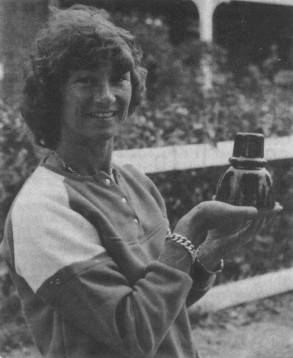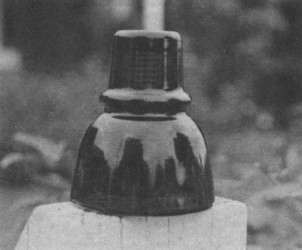Foreign Insulators
by Marilyn Albers
Reprinted from "INSULATORS - Crown Jewels of the Wire", August 1984, page 6
INSULATOR DISCOVERIES FROM GREECE AND AUSTRALIA
Once again we have a guest editor! This month he is Bill
Ogden (Virginia, Minnesota), who recently made a trip to Greece and saw all
kinds of good insulators. Unfortunately, he did not have success in bringing any
of them home with him, but at least now we know those insulators are out there.
This is good news because, until Bill's letter came, the only information we had
on Greek insulators was an interpretation of the OTE marking, and it had only
been found on U-1267 and U-1268. I'm happy to be able to share with you the
following account of his trip.
C.T.E. (ORGANISMOS TELEFONOS ELLADOS) AND OTHER
GREEK INSULATORS
By WILLIAM C. OGDEN
This June I took a two-week guided tour of
the Greek mainland and islands. In addition to seeing much beautiful countryside
and many other interesting sights, I was able to observe hundreds of miles of
open-wire communication and power lines. For a hard-core insulator fan, this
was certainly a treat.
Let's consider a description of the insulators and line
construction practices. The great majority of the telephone insulators are white
porcelain with the O.T.E. underglaze embossing in blue ink. The O.T.E. is the
telephone company of Greece; our guide said it is a branch of Ma Bell! I saw two
variations of this embossing: one is simply O.T.E.; the other has the letters
A/R in a triangle under the other embossing. I saw six styles of these O.T.E.
embossed insulators. See sketches and approximate U-numbers of these.
The U-1938
has a metal cap covering the dome, and I'd guess this is a form of the so-called
"dry spot" insulator. The U-1898 is a transposition insulator, but in
many instances wasn't used as a tramp insulator would be used in America.
Frequently it served as a regular insulator -- a single wire tied to the top
groove. It was also used on the eight-inch, four-insulator, point transposition
bracket. The wires dead-ended at each insulator, and were reconnected by
jumpers. I also noted the U-1898 was used to make a point transposition without
a bracket, by having two of these side-by-side on the crossarm -- see sketch.
In
addition to the white, I saw a few unidentified brown porcelain -- some were a
dull finish; the others a dark shiny brown. A few poles of this line carried
some of the same style in a dark green glaze -- this would be a real goody! I saw
one white porcelain with the blue underglaze  (SPAP); I have no idea what this
stands for. I saw some clear glass, which looked very much like the CD 128, or
could it have been the CD 407? This was the only type of glass I saw on the
communication lines. The common practice was to use wood poles with 24" or
48" steel crossarms fastened to the pole by means of a yoke going around
the pole. By using four regular steel pins and four "J" pins, and
reducing the space between the wires, it was possible to carry eight wires on
the 48" arm; see sketch.
(SPAP); I have no idea what this
stands for. I saw some clear glass, which looked very much like the CD 128, or
could it have been the CD 407? This was the only type of glass I saw on the
communication lines. The common practice was to use wood poles with 24" or
48" steel crossarms fastened to the pole by means of a yoke going around
the pole. By using four regular steel pins and four "J" pins, and
reducing the space between the wires, it was possible to carry eight wires on
the 48" arm; see sketch.
Some of the low-voltage distribution power lines
carried four wires on a "rack" fastened to the side of the pole, using
four porcelain spools; another type of rack used pin-type porcelain insulators
cemented onto the pin. The higher voltage lines I saw used either pin types or
suspensions. Most of the pin types were brown porcelain, but I saw many glass --
either clear or aqua -- six or eight inch suspension discs, and a clear glass pin
type that resembled the medium-sized Pyrex; this style was common in certain
areas. I noted some familiar shapes; one that was used quite frequently looked
like one of the larger "hi-top" designs, such as the U-802; there was
another that looked like the U-833 or 834. There were also several types of
two-piecers that looked very similar to what one sees in the States. One of the
most interesting designs was a straight-sided, top-groove insulator; probably
it was about 5" x 7" -- see sketch -- I've never seen anything like this
before! Frequently, the six inch suspension discs were used as strain insulators
on the brace wires; I've never seen this practice in America.
I've enjoyed
writing this article and sharing my experiences. If anyone has any questions or
comments, feel free to contact me.

These four sketches represent the four types
or styles of the white porcelain O.T.E.- embossed insulators. "A" is
similar to U-1268 -- 3 x 4-1/ 2"; there is a smaller version of the same
style -- similar to U-1243 -- 2-3/4 x 3-3/4". Type "B" also was
seen in two sizes; the larger is similar to U-1743 -- 3-1/2 x 5-3/4", and a
smaller one similar to U-1652. Type "C" is evidently some type of
"dry-spot" insulator -- it has a metal cap on top; it seems to be
U-1938. Type "D" is a transposition insulator, U-1898.

Sketch
"E" is one of the most interesting power insulators I've seen. Dull
brown glaze; about 5 x 6"; wonder who made it? Common in certain areas;
one-inch pin type.

This would be a typical example of line construction
telephone -- eight wires on a 48" steel crossarm, making use of the
"J" pins.

Sketch "G" is the most unusual way of making a
point transposition without a bracket that I've seen. Two tramp insulators
U-1898 -- are side-by-side on the arm, and the wires cross at that point. It
would probably work, but would seem to place a considerable stress on the wires,
pins and insulators
LAURA VAN DER ENDT FINDS TWO GOODIES!
I've spoken so often
of my friend Laura that I'm sure you all feel you know her by now! What a
tremendous help she has been in supplying us with information on insulators
found in Australia. She has also sent numerous shadow drawings with
measurements, so we can get an accurate picture of what these insulators look
like. Add to that the many new markings she has contributed to our files. Laura
you've made yourself indispensable!

Pictured here she is holding a very rare
dark green glass insulator, similar in shape to the more common porcelain
version, U-1502, which is (was) a telegraph insulator used on the Overland
Telegraph Line running from Adelaide to Darwin. We're presuming this new find in
glass was also used in the same way.
The embossing ISOREX / 1030 indicates that
the insulator was manufactured in France and subsequently exported to Australia
for use there. As soon as we can get the shadow profile from Laura, this
beautiful insulator shall have a new C.D. number.

A close-up of the same insulator.

The third picture shows an
English made insulator that is one of the original Overland Telegraph Line
insulators, dating back to 1890. Laura says, "The bolt on the top unscrews,
to allow two wires to be held in place between the metal parts of the insulator.
There are no markings at all on the insulator, but at that time all insulators
were imported, so it is safe to assume they were made in England." Laura
waited six years to find this rare bird.
| 